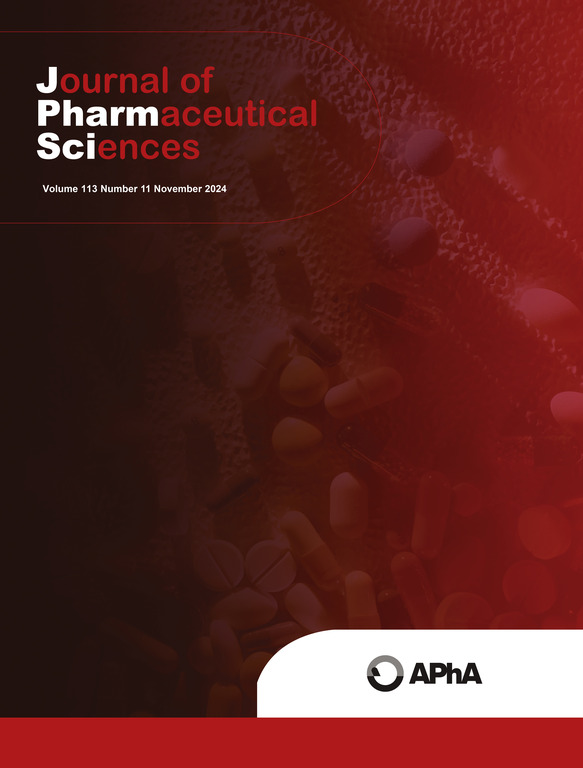Impact of citrate on mitigating iron mediated polysorbate 80 degradation in biotherapeutic formulation placebos
IF 3.7
3区 医学
Q2 CHEMISTRY, MEDICINAL
引用次数: 0
Abstract
Polysorbate 80 (PS80), a widely used polymeric surfactant in biotherapeutic formulation, possesses a unique structural composition that effectively prevents protein aggregation in highly concentrated protein drug formulations. However, PS80 is susceptible to hydrolysis, due to the presence of fatty acid esters that can be enzymatically hydrolyzed, The unsaturated bonds in the fatty acids are prone to oxidative degradation when exposed to air, especially in the presence of transition metals such as iron and copper, which may be introduced during production and purification processes or from contamination in raw materials used in drug formulation. The degradation of PS80, particularly through metal-mediated oxidative degradation, poses a significant challenge for the industry. Among the identified trace metals, iron plays a crucial role as the redox reaction between ferrous ion (Fe(II)) and ferric ion (Fe(III)) generates radicals that initiate the degradation process. In order to investigate the impact of iron on PS80 degradation and understand the mechanism of iron-catalyzed oxidation, we utilized charge-reduction mass spectrometry and two-dimensional ion density mapping technologies to characterize the degradation of PS80. This method has proven to be a convenient and effective tool for the quick and detailed profiling of PS80, allowing for visual monitoring and examination of the changes that reflect the difficult-to-identify and easy-to-miss oxidized species of PS80. Additionally, a high-performance liquid chromatography coupled to inductively coupled plasma mass spectrometry method was developed for the separation and measurement of Fe(II) and Fe(III). Through this investigation, we determined that the involvement of Fe(II)/Fe(III) in PS80 degradation is a temperature dependent process. Furthermore, we found citrate not only promotes the conversion of Fe(II) to Fe(III), but it also chelates Fe(III) and prevents its reduction to Fe(II), thus inhibiting the initiation of the PS80 degradation. Therefore, the addition of citrate can be a crucial ingredient for controlling the degradation of PS80 in biologic drug substances and products. Overall, this investigation has provided valuable insights to enhance product stability, optimize processes, and ensure the quality of formulations containing PS80.
柠檬酸盐对缓解生物治疗配方安慰剂中铁介导的聚山梨醇酯 80 降解的影响
聚山梨醇酯 80(PS80)是一种在生物治疗配方中广泛使用的聚合物表面活性剂,它具有独特的结构组成,可有效防止高浓度蛋白质药物配方中的蛋白质聚集。脂肪酸中的不饱和键在暴露于空气中时容易发生氧化降解,尤其是在有铁和铜等过渡金属存在的情况下。PS80 的降解,尤其是通过金属介导的氧化降解,给行业带来了巨大挑战。在已确定的痕量金属中,铁起着至关重要的作用,因为亚铁离子(Fe(II))和铁离子(Fe(III))之间的氧化还原反应会产生自由基,从而启动降解过程。为了研究铁对 PS80 降解的影响并了解铁催化氧化的机理,我们利用电荷还原质谱法和二维离子密度图谱技术来表征 PS80 的降解过程。事实证明,这种方法是快速、详细分析 PS80 的便捷、有效工具,可以直观地监测和检查反映 PS80 难识别、易遗漏的氧化物种的变化。此外,我们还开发了一种高效液相色谱耦合电感耦合等离子体质谱法,用于分离和测量铁(II)和铁(III)。通过这项研究,我们确定了铁(II)/铁(III)参与 PS80 降解的过程与温度有关。此外,我们还发现柠檬酸盐不仅能促进 Fe(II) 转化为 Fe(III),还能螯合 Fe(III)并阻止其还原为 Fe(II),从而抑制 PS80 降解的开始。因此,添加柠檬酸盐可以成为控制生物药物物质和产品中 PS80 降解的关键成分。总之,这项研究为提高产品稳定性、优化工艺和确保含 PS80 制剂的质量提供了宝贵的见解。
本文章由计算机程序翻译,如有差异,请以英文原文为准。
求助全文
约1分钟内获得全文
求助全文
来源期刊
CiteScore
7.30
自引率
13.20%
发文量
367
审稿时长
33 days
期刊介绍:
The Journal of Pharmaceutical Sciences will publish original research papers, original research notes, invited topical reviews (including Minireviews), and editorial commentary and news. The area of focus shall be concepts in basic pharmaceutical science and such topics as chemical processing of pharmaceuticals, including crystallization, lyophilization, chemical stability of drugs, pharmacokinetics, biopharmaceutics, pharmacodynamics, pro-drug developments, metabolic disposition of bioactive agents, dosage form design, protein-peptide chemistry and biotechnology specifically as these relate to pharmaceutical technology, and targeted drug delivery.

 求助内容:
求助内容: 应助结果提醒方式:
应助结果提醒方式:


